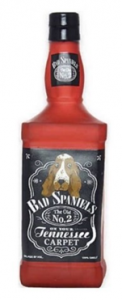By Mitchell Feller with assistance from Jessica Li
VIP Products sells pet toys. Among its products is a line of novelty squeak chew toys that resemble popular bottled and canned drinks but modified with pet-related puns. Some examples of these toys are “TailFleas – The Original Irish Flea” (Baileys – The Original Irish Cream), “Cataroma Extra” (Corona Extra), and “Mountain DROOL” (Mountain Dew). In 2013, VIP introduced its “Bad Spaniels” squeaky toy, based on Jack Daniel’s Old No. 7 Tennessee Sour Mash Whiskey. While some companies might be amused by or at least tolerate these novelty products, Jack Daniel’s was not one of them and they demanded that VIP stop selling it. This led to a 10-year journey all the way to the U.S. Supreme Court which, in June 2023, unanimously held that, parody or not, when a party is using another’s trademark as a source identifier for their own products, a First Amendment exception to trademark infringement does not apply.
At its core, trademark law is intended to avoid customer confusion about the source of goods or services. A trademark owner can bring an infringement claim to stop a third party’s use of their mark if that use is likely to cause such confusion. An exception that allows a third party to use someone else’s trademark without infringement, known as the Rogers test, balances the rights of the trademark owner to prevent third party use of their marks with the third party’s freedom of speech under the First Amendment. Under Rogers, when a trademark is included in an “expressive work”, an infringement claim cannot stand unless (1) the challenged use of a mark “has no artistic relevance to the underlying work” or (2) the use “explicitly misleads as to the source or the content of the work.” The Rogers test (which originated in a dispute about Fellini’s use of the name of famous dancer Ginger Rogers in a film title) has been applied to a wide variety of expressive works.
The Bad Spaniel toy and a bottle of Jack Daniel’s are shown below:


Here, VIP argued that its Bad Spaniels toy was an expressive work of parody and so under Rogers, there could be no trademark infringement. The district court disagreed, first finding that Rogers did not apply because VIP was using the accused marks as source identification, and then ruling that there was infringement because consumers were likely to be confused about the source of the toy. On appeal, the Ninth Circuit reversed and held that the Rogers test applied broadly, including here. On remand, the district court then found that Jack Daniel’s could not meet either prong of Rogers and so now there was no infringement. This was upheld by the Ninth Circuit and Jack Daniel’s appealed to the Supreme Court.
In its analysis, the Supreme Court emphasized the purpose of trademark law to tell the public “who is responsible for a product”. Addressing the trademarks here, the Court recognized that Jack Daniel’s has registered trademarks for “Jack Daniel’s”, “Old No. 7”, the arched Jack Daniel’s logo, the filigree label, and the shape of the square bottle itself. The Court also detailed how the asserted marks were being used by VIP:
- The dog toy “is about the same size and shape as an ordinary bottle of Jack Daniel’s”
- The “faux bottle” follows the original bottle by using a “black label with stylized white text and a white filigreed border”
- The toy has the product name (Bad Spaniels) “in a like font and arch” to that on the Jack Daniel’s bottle; and
- The phrase “Old No. 2 On Your Tennessee Carpet” replaces “Old No. 7 Tennessee Sour Mash Whiskey.”
Most telling, the Court specifically pointed out that VIP itself was using design features of its Bad Spaniels product as its own trademark, including by putting the Bad Spaniels logo on a hangtag shaped like the rear label of a bottle of Jack Daniel’s.
In its unanimous decision, the Court narrowed the circumstances where Rogers could apply and held that the Rogers test is inapplicable “when the accused infringer has used a trademark to designate the source of its own goods—in other words, has used a trademark as a trademark.” It does not matter whether the accused use of the mark may also have some expressive content and convey a message beyond source identification. Whatever protection that parodies may have under the First Amendment, the protection does not immunize the user from a trademark infringement claim when the copied mark is used as a source identifier.
The case was remanded back to the District Court to reconsider whether there is a likelihood of confusion. In doing so the Supreme Court specifically explained that while Rogers did not apply, questions about the expressive nature of the use of the marks by VIP are still relevant in assessing a likelihood of infringement: “[T]o succeed, the parody must also create contrasts, so that its message of ridicule or pointed humor comes clear. And once that is done (if that is done), a parody is not often likely to create confusion. Self-deprecation is one thing; self-mockery far less ordinary. So although VIP’s effort to ridicule Jack Daniel’s does not justify use of the Rogers test, it may make a difference in the standard trademark analysis.”